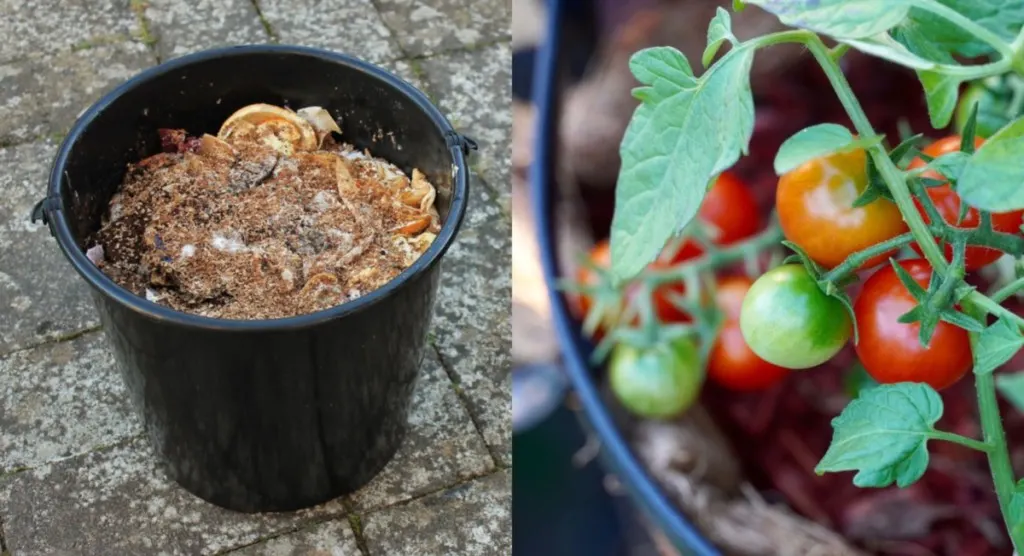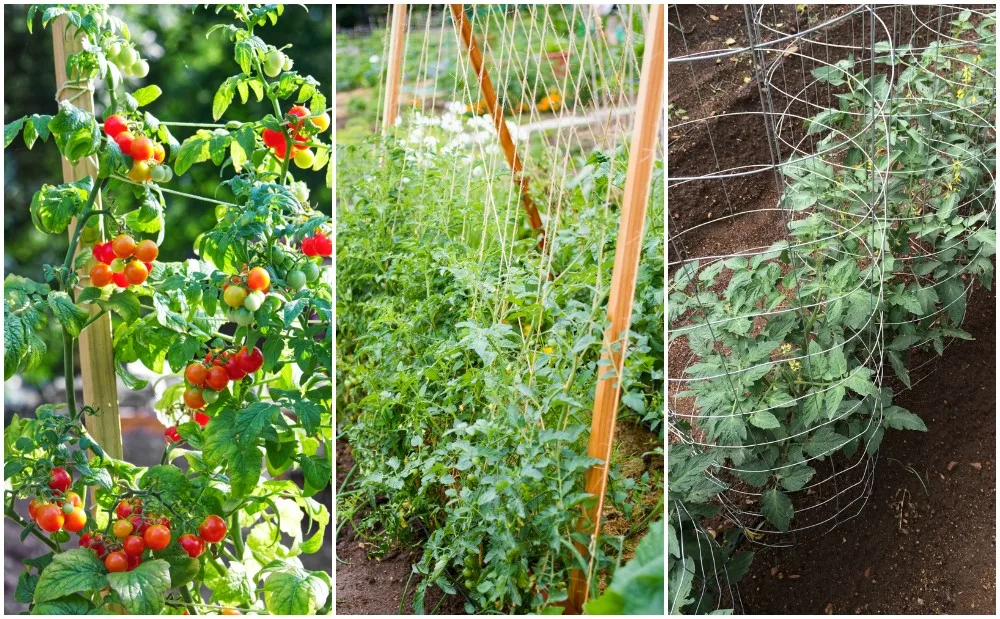
There are several different schools of thought when it comes to supporting tomato plants. Some gardeners are advocates of simply allowing tomato plants to sprawl where they will.
But if you have a smaller garden, or want a more orderly food producing area, supporting tomato plants in some way is usually a good idea.
In this article, I want to talk about why supporting tomatoes is a good idea. I’ll discuss the different types of tomato support you can consider.
We’ll then look at the things you should consider when choosing tomato supports. And go on to look at 38 tomato support ideas for high yielding tomato plants.
Read on to find plenty of inspiring ideas for your tomato garden.
Why Support Your Tomatoes?
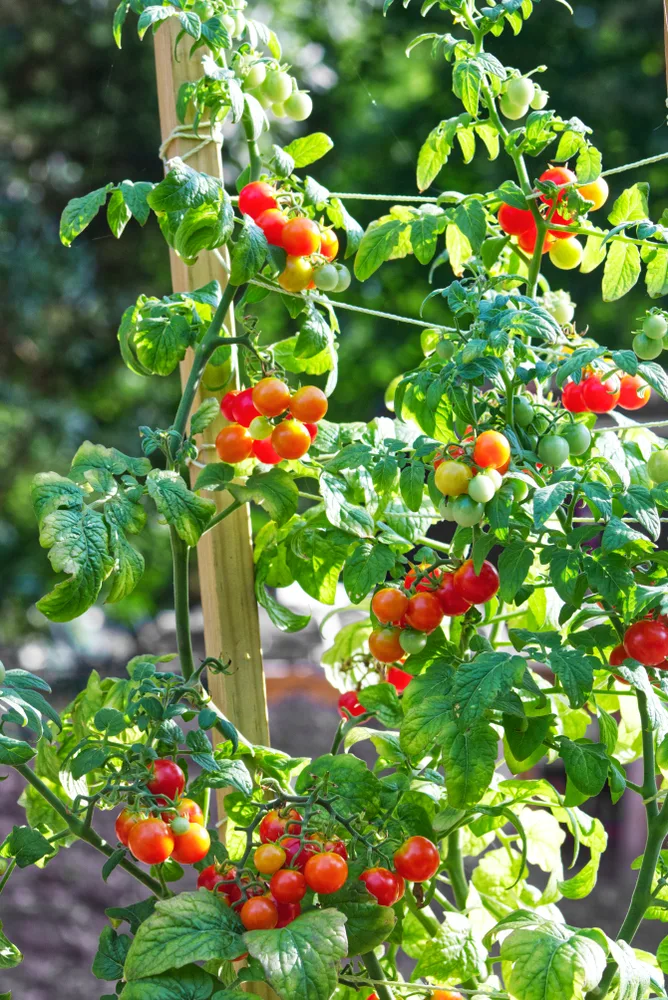
Supporting tomatoes is better for the plants themselves, and better for you. While tomatoes will generally have an upright growth habit, they can easily be damaged by winds and weather. Providing some support can help them to grow strong and keep their stems unbroken and fruits up off the ground.
Related Reading: 10 Pro Tips For High Yielding Tomato Plants
I found out the hard way that one misstep or wayward creature can easily damage or destroy a tomato plant or its yield. The risk of accidental damage is much higher if plants are unsupported.
I had one unsupported tomato plant in my polytunnel a few years back which I managed to clumsily destroy by stepping on a main stem that had fallen over the path. Years back, my dog knocked over a mature tomato plant and squashed some fruits when he was coming across my allotment to say ‘hello’.
But I’ve got off lightly. A fellow gardener on our former allotment site lost a whole row of tomatoes in one evening due to high winds and a wind tunnel effect caused by nearby buildings.
Now, I tend to grow my tomatoes in my polytunnel using a cordon method for support. (More on this below). Usually I enjoy a naturalistic and rather rustic style of gardening. But tomato plants are one thing that I do feel benefits from some form of support and order.
Supporting tomato plants does not just offer some protection against accidental damage and weather. It can also help to reduce tomato disease through limiting overcrowding and keeping plants from resting too closely against one another.
Finally, using tomato supports of one kind or another can help make harvesting easier. Rather than having to lift and move plants aside to find fruits low down, the fruits are easy to find, often at a more comfortable picking height.
Different Types of Tomato Support
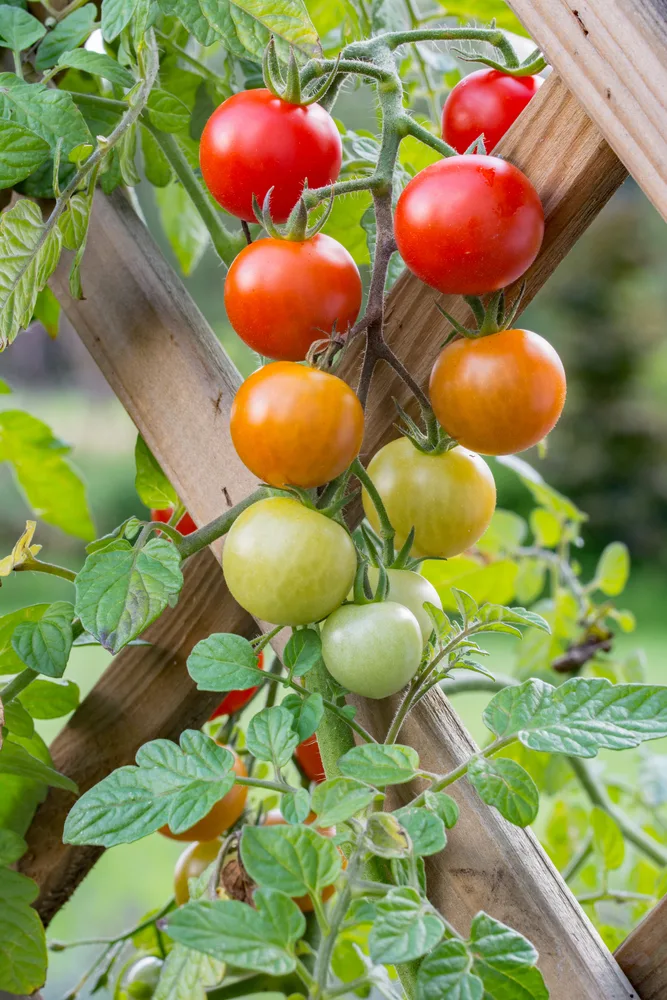
The most common ways to support tomato plants is with:
- Trellis, or against fencing.
- Tomato cages or fully surrounding supports.
- A frame supporting a series of wires or strings for ‘cordon’ type growing.
- Simple stakes beside each plant to which each tomato plant is tied.
We’ll explore ideas of each of these different types of tomato support below, as well as providing a couple more options if you would rather not go down the support route.
Things to Consider When Choosing Tomato Support Ideas
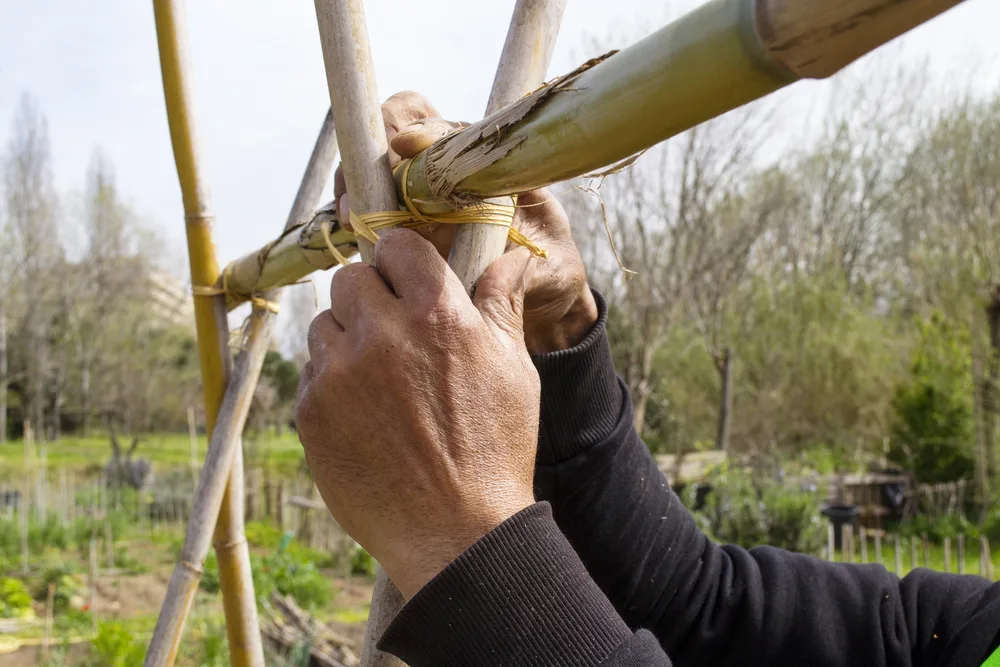
There are a number of important things to consider when choosing how to support your tomato plants.
The first thing to think about is your location. Where you live, and where exactly you will be growing your tomatoes will often dictate which type of support is best for you. Think about how windy your site may get. And how likely tomato plants are to be disturbed by human or animal activity.
You will also need to consider what type of tomato you are growing. You may focus on the type of fruits a tomato plant will produce, and think about whether these will be good for salads, for canning, or for cooking. Heavier beefsteak tomatoes, for example, will generally require more support than varieties with smaller fruits.
But another thing to consider is whether the variety or varieties you are growing is determinate or indeterminate.
Determinate tomato varieties have a limited growth pattern. They will tend to require much less support and can be ideal for growing in containers.
Indeterminate types will continue to grow and form fruits over a longer period. These types often grow into much larger plants. So they will generally require more support.
A trellis can allow you to grow tomatoes vertically so that they take up a little less space. This can be a great solution if you are growing tomatoes up against a wall or fence. Though free-standing trellises can also be created for almost any growing area.
Cages are free-standing solutions that can work almost anywhere. They ensure that tomato plants are not only protected on one side, but have a structure which surrounds them completely.
Cordon growing is often considered to be the ultimate space saving solution. Though simple stakes could also serve a similar purpose in certain settings.
Tomato Trellis Ideas
First of all, let’s take a look at some of the many different trellis ideas you could consider. If you have decided that a trellis is the right type of tomato support for you, the next decision will be whether you will buy one, or make one yourself.
Buying a tomato trellis can be more costly, of course, than making your own. But if you are keen to get started, and short on time, here are some options that you could buy:
- Willow Trellis
- Bamboo Tomato Trellis
- Wooden Planter and Trellis
- Metal Tomato Trellis
- Expandable Trellis
- Folding Trellis
- Archway Trellis
DIY Tomato Trellis Ideas
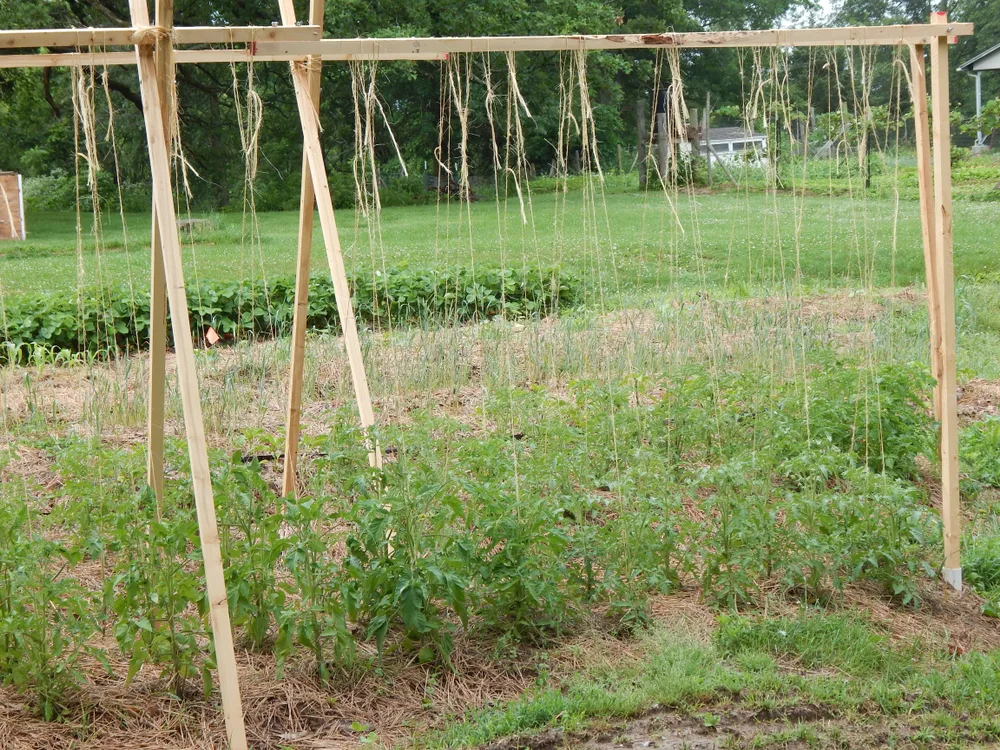
Taking the DIY approach could, however, offer a range of rewards. By making your own trellis, you can go greener. Often, you can make use of natural materials, or materials that might otherwise have been thrown away.
Here are a few interesting DIY trellis ideas that you might like to consider:
DIY Natural Branch Trellis
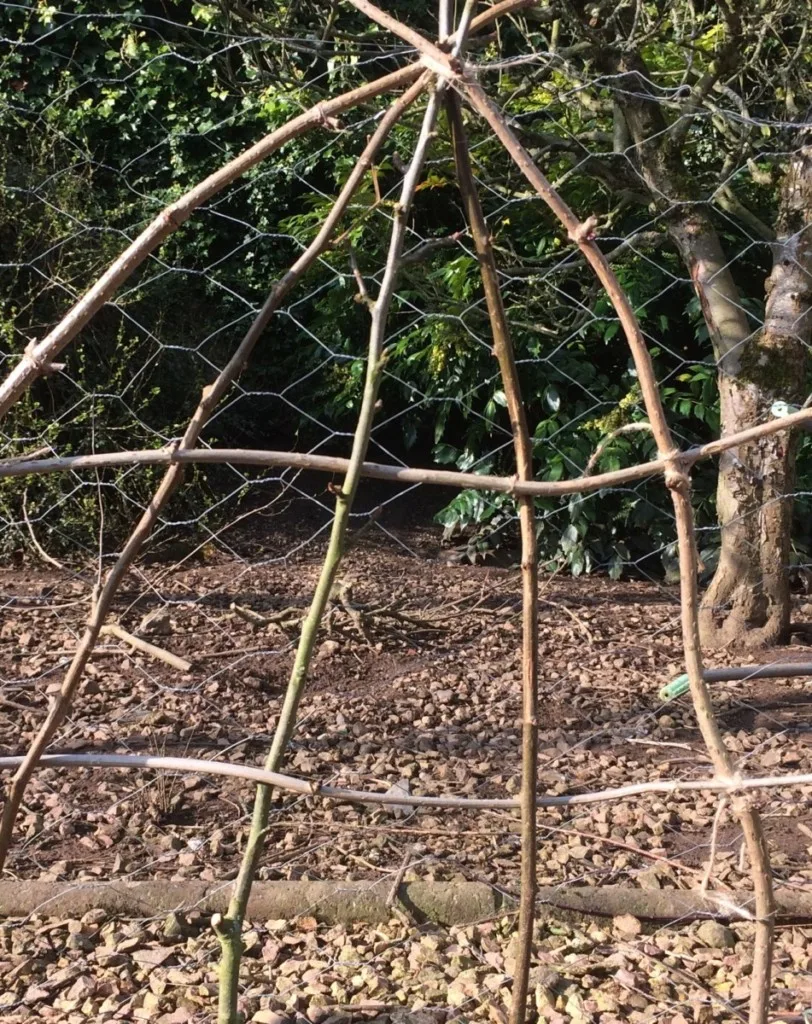
One of the cheapest and easiest ways to make your own trellis is simply to make one using natural branches from your garden, woven into one another and tied together with natural twine. You can make a trellis from branches in a number of different shapes and sizes.
With a rustic and natural look, these trellises can look great in your kitchen garden. Plus it will be practically free to make, and will not pose a waste problem at the end of its useful life.
Here’s my guide to making your own rustic trellis out of branches.
DIY Bamboo Trellis
If you grow your own bamboo in your garden, there are a range of ways to make use of the canes. Bamboo canes can be used to make your own DIY tomato support trellis.
As with the natural branch idea above, bamboo canes can simply be tied together with natural twine to create a number of different trellis designs.
Build a Bamboo Trellis @ finegardening.com.
Reclaimed Wood Trellis
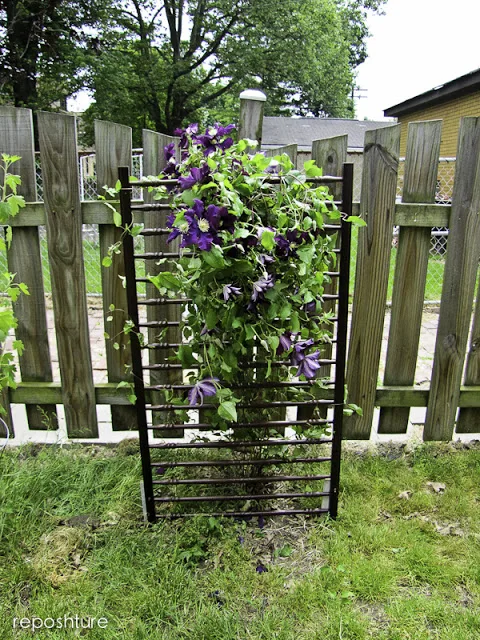
Any pieces of reclaimed wood can be used in a similar way, to create a lattice-like or ladder-like structure to support your tomato plants. For example, check out this example which repurposed part of an old crib:
Crib Trellis @ reposhture.blogspot.com.
Pallet Wood Trellis
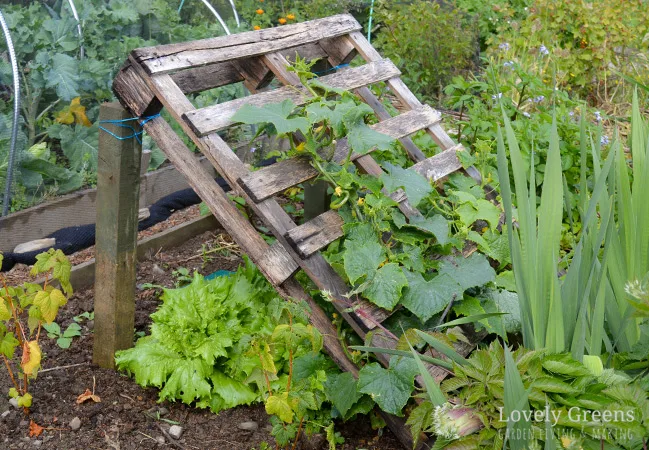
For a sturdier trellis, pallet wood can be a particularly useful type of reclaimed timber. Pallet wood trellises can be very strong and sturdy, great not only for tomato plants but also for squash, pumpkins and other vining plants you may grow.
No Tools Required DIY Pallet Trellis @ lovelygreens.com
Chicken Wire Trellis
If you have some old chicken wire lying around from other projects, stapling a piece inside a simple wood frame can give you a quick and easy DIY trellis to use for your tomato plants.
Check out this example which uses chicken wire and an upcycled window frame:
Chicken Wire Old Window Trellis @ rindymae.blogspot.com.
Livestock Panel Trellis
An old livestock panel or section of fencing could also be repurposed as a simple and sturdy tomato trellis.
Placed upright, or leant up against a fence, one of these metal fencing sections can give your tomato plants the support they need as they grow.
DIY Garden Trellis @ frugalfamilyhome.com.
Reclaimed Pipe Trellis
Old piping left over from a plumbing job around your home could also come in handy in the vegetable garden. Old pipes are often used to make hoophouse frames for new greenhouse structures. But you could also use some to make a reclaimed pipe trellis.
Reclaimed Bicycle Wheel Trellis
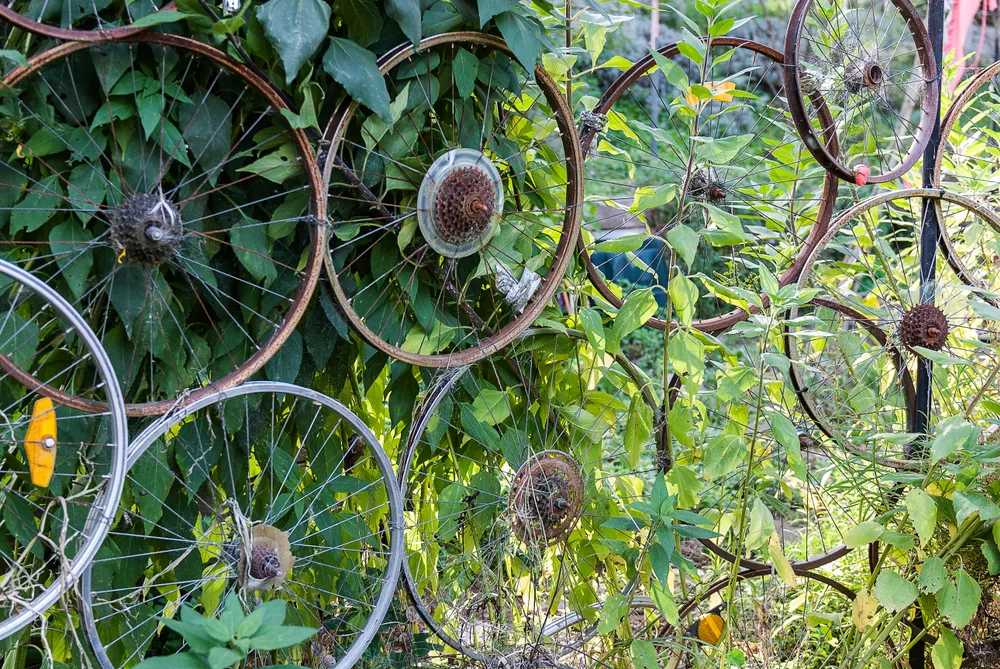
This is another interesting idea to consider in place of a full trellis built up against a wall or fence.
Simply affix a few old bicycle wheels against the structure. The spokes make excellent anchor points to tie tomato plants to as they grow. And the whole thing can be a quirky piece of garden artwork too.
Bicycle Wheel Trellis @ pinterest.co.uk.
Reclaimed Fishing Net Trellis
Old fishing nets can entangle wildlife and often wash up on beaches. If you live near the beach, you may be able to reclaim and recycle these old pieces netting.
Take old tangled nets from the beach and use them hung over walls or fences, or spread out inside a wooden frame. Not only could this provide a support for tomatoes and other plants. It could also let you do your part to help tackle plastic pollution.
Reclaimed Fishing Net Trellis @ hobbyfarms.com.
By tying your tomato plants into your trellis with natural twine as they grow, you can help keep plants in order and growing strong. And you will keep fruits up off the ground and easy to harvest.
Tomato Cage Ideas
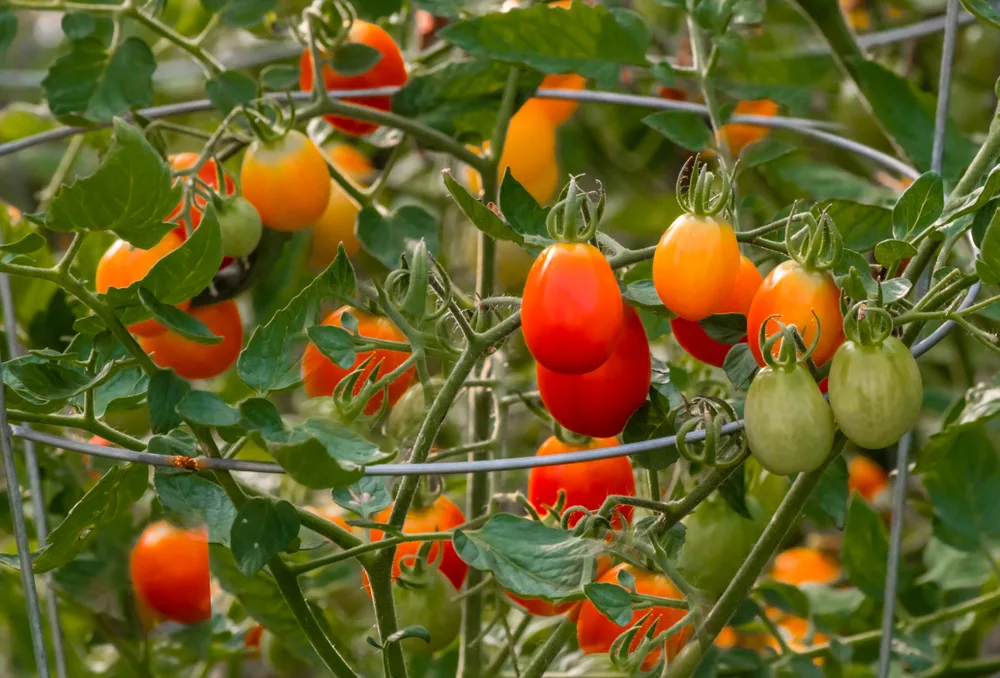
Next, let’s consider some of the different types of tomato cage that you could buy or make. First of all, here are some of the tomato cages that you could buy:
DIY Tomato Cages
Of course, as with trellises, there are also a number of tomato cages that you could make yourself. Here are just some examples of DIY tomato cage ideas you could consider:
DIY Natural Branch Tomato Cage
Natural branches are such a useful and flexible resource. And they are something that many of us have access to.
When you prune garden trees etc., keep the branches to one side and use them for supports and other purposes around your garden. Branches can be used in a range of different ways to make cages to support tomato plants.
DIY Tomato Cages @ pinterest.com.
Woven Branch Tomato Cage
You can also use the same technique as you might use to make a woven fence to make a round cage structure for tomato plants. Place uprights into the ground, then weave bendy branches in and out of these to create support cages around your tomatoes.
Wattle Tomato Cage @ enotamountainretreat.wordpress.com.
Upcycled Wood Tomato Cage
You don’t have to restrict yourself to natural branches either. Remember that you can use a wide range of different pieces of upcycled or reclaimed wood to make sturdy cage supports for your tomato plants.
DIY Wooden Tomato Cages @ ellaclaireinspired.com.
Bamboo Tomato Cage
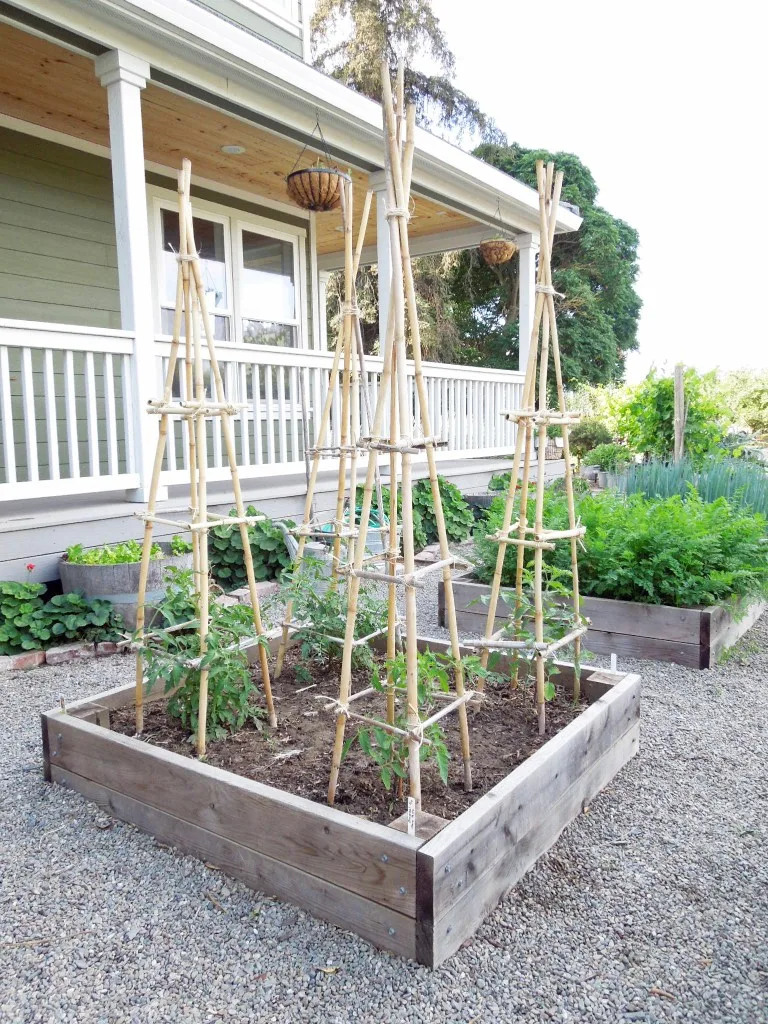
Again, if you have bamboo, this can also be used to make a number of different tomato cages. For example, you could form bamboo canes into tipi forms, or make circular lattice structures, or box-like square cages.
Bamboo Tomato Cage Tutorial @ thepaintedhinge.com.
DIY Chicken Wire Tomato Cage
A piece of old chicken wire wrapped around to form a circle can be a cheap and easy way to make some lightweight tomato cages.
How To Make Tomato Cages With Chicken Wire @ wirefence.co.uk.
Metal Fencing Tomato Cage
If you want something sturdier, for bigger tomato plants, or those with heavier fruits, you could also bend around old metal fencing panels in a similar way.
Metal Rebar Tomato Cage
Or for something even sturdier, you can even use the metal reinforcement mesh used in concreting for the purpose. This will be sturdy enough to provide support year after year for even the most unwieldy and large of plants.
How To Make a Tomato Cage With Rebar @ homeguides.sfgate.com.
Reclaimed Pipe Crop Cage
Just as you can use old piping to make trellis, so you can form it into cage structures for your tomato plants. Simply join the pieces together to make box-like structures rather than ladder-like forms.
Wooden Lattice Grow Box
One interesting thing to consider is that a wooden trellis with an open lattice, when placed horizontally over a bed, can act like a series of smaller tomato cages and give support to plants as they grow up through each of the holes.
Tomato Grow Box Lattice @ flickr.com.
DIY Wooden Obelisk
If you are growing tall tomato plants, you could consider making your own sturdy wooden obelisks, rather than just smaller, shorter tomato cages. This is a versatile structure that you could use year after year to grow a range of crops.
Easy Garden Obelisk @ flowerpatchfarmhouse.com.
Reclaimed Step Ladder Obelisk
But if you don’t have the time or energy to make your own, how about using an item you may already have lying around? An old stepladder with reinforcing bars across the sides could be the perfect easy solution.
Cordon Support Ideas
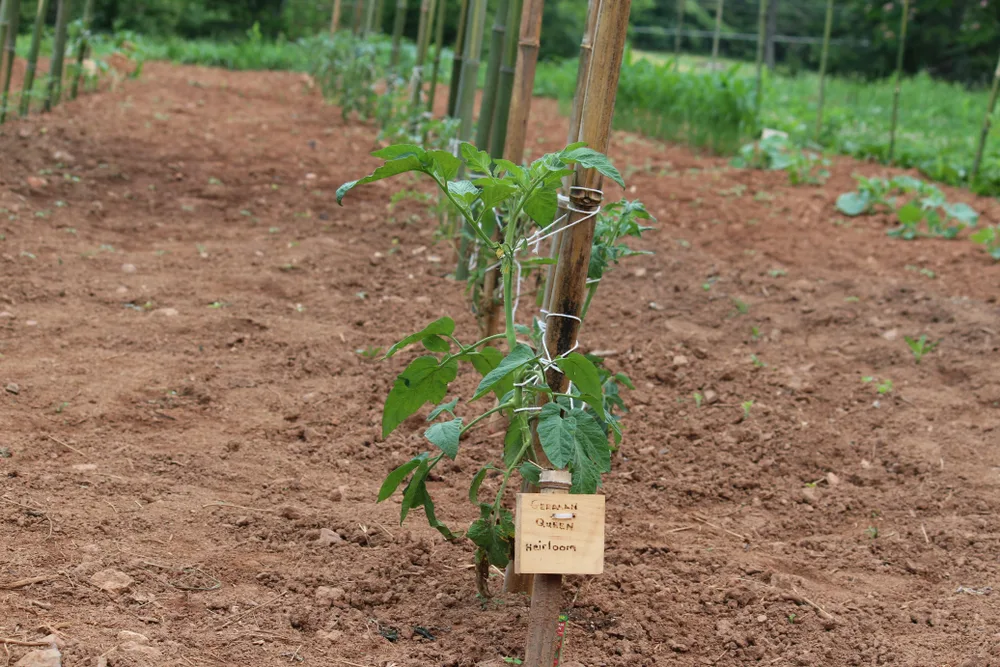
Trellis and cages can both be good solutions in certain settings. But if you are short on space, cordoning tomatoes is arguably the best space-saving option.
In a cordon system, tomatoes are grown up individual support wires, strings, canes or stakes. Rather than being allowed to form bushes, cordoned tomatoes are encouraged to form tall, single stem plants. This is a great choice for any indeterminate varieties.
Here are a few ways to support cordon wires when you are implementing this type of system:
Polytunnel Crop Bar Cordon Support
Personally, I grow my tomato plants inside a polytunnel, since the climate is not optimal for growing them outside where I live. My polytunnel has long horizontal bars running along across near the top of each hoop.
I string sturdy metal wire tautly between these crop bars at either side. To these wires, at regular intervals, I tie lengths of natural twine which are anchored into the ground with metal tent pegs. One tomato plant is placed near the base of each of these strings and tied onto them as they grow.
A-frame Cordon Support
If you do not already have a support structure such as a polytunnel from which to hang support wires or strings, you can create your own. One idea is to make an A-frame structure.
T-Bar Cordon Frame
You can also make a T-bar type support from which to hang your cordon wires or strings.
Twine Cordons on a Square or Rectangular Frame
Or make a square or rectangular frame to cover a raised bed or other growing area, with wires or strings hanging from it to allow for the best plant spacing.
Simple Tall Wooden Stakes or Canes
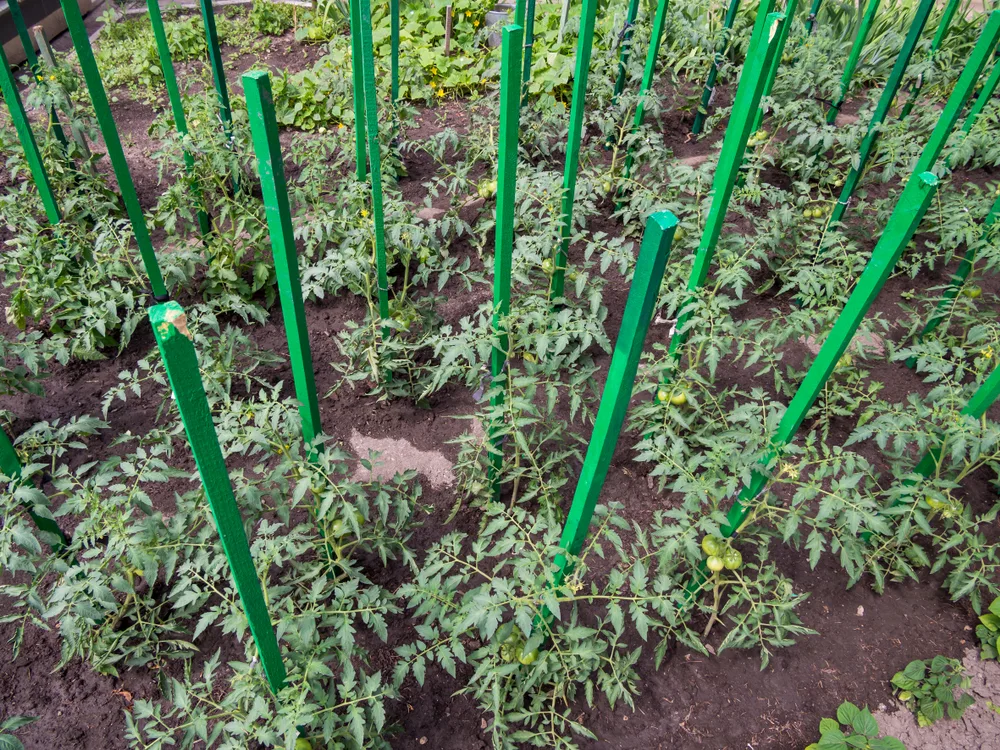
You can also simply use single wood branches, stakes or garden canes – one for each plant. As long as these are strong and tall enough, forcing them into the ground can hold them upright. And tying plants to them as they grow can provide sufficient support.
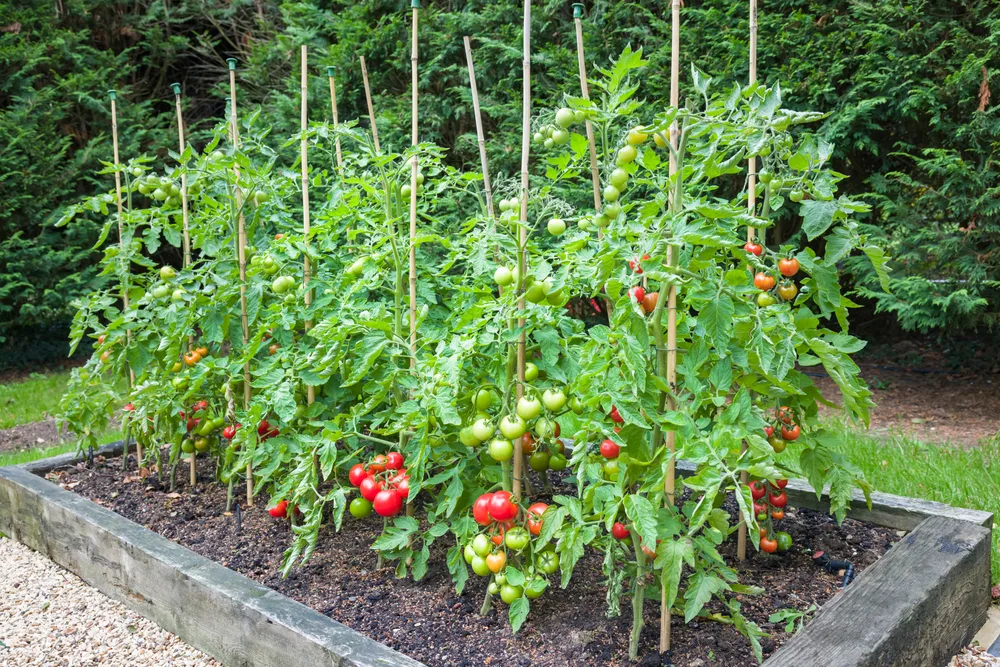
Other Tomato Support Ideas
You do not necessarily have to make supports at all. If you are looking for a more hassle free, even easier way to grow tomatoes, there are a couple of other ideas to consider:
No Support – Grow Tomato Plants Upside Down
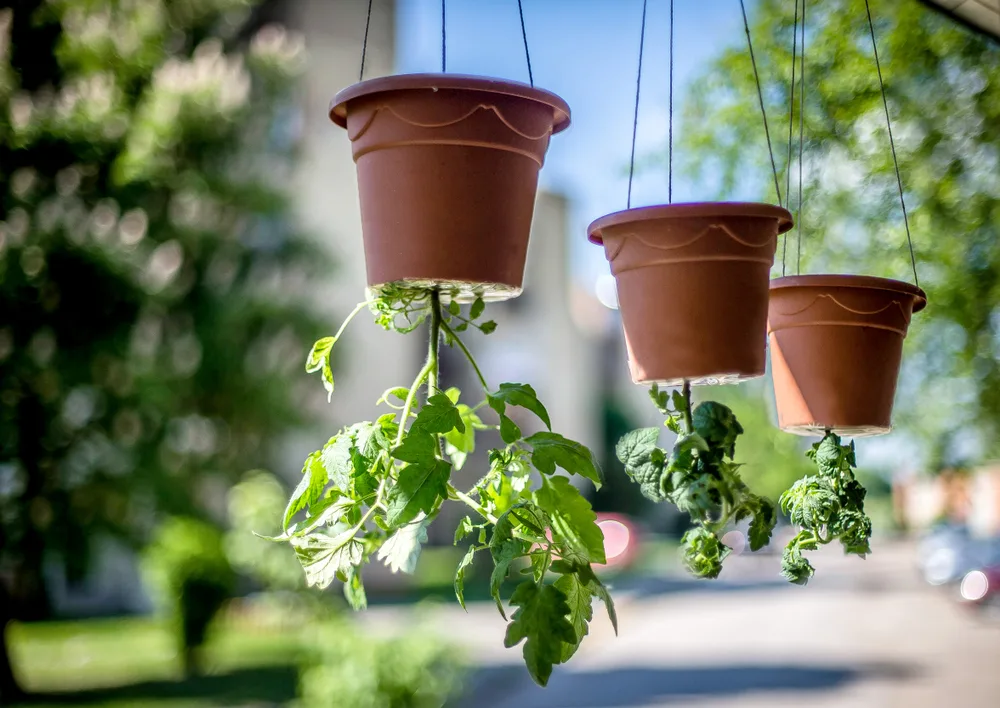
You may not need to support tomato plants at all. One interesting option to consider is growing tomato plants in hanging containers. You could even grow tomato plants upside down.
Other Plants in a Polyculture
Finally, it may be worthwhile considering how other plants placed in a polyculture could help. As members of a tomato guild, certain companion plants could potentially help to keep tomato plants upright.
It is important to avoid excessive competition for nutrients and resources, and to avoid overcrowding. But it may be possible to avoid the use of unnatural supports in certain cases by choosing the right combinations of plants.
The ideas above should have given you some inspiration. When you look around at what you have, you will likely find plenty more interesting tomato support ideas to consider.
Get the supports sorted soon, and they can be ready for when you get your tomato plants in the ground.
Read Next:

Get the famous Rural Sprout newsletter delivered to your inbox.
Including Sunday musings from our editor, Tracey, as well as “What’s Up Wednesday” our roundup of what’s in season and new article updates and alerts.



